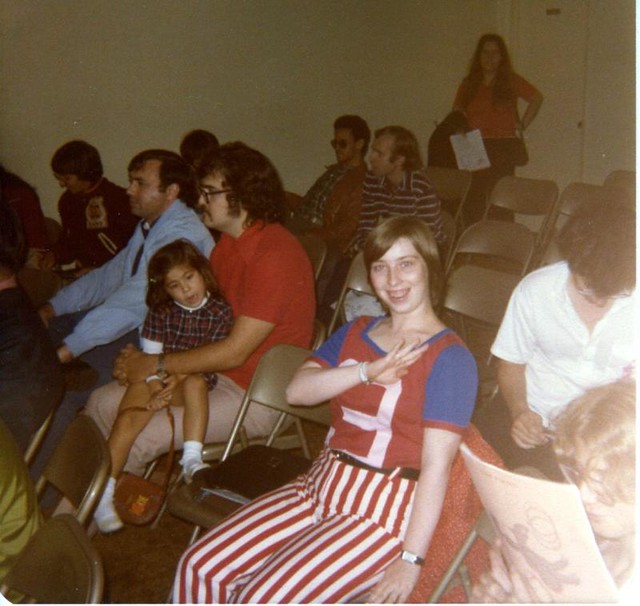
Science Ninja Team Gatchaman cosplayers, old-school tech, and Fred Patten and Mark Merlino doing their thing: https://www.flickr.com/photos/56928511@ ... 215585205/ (^_^)

I know, right? The combined joys of 'deadstock' items (the show is now old, we gotta move this out for the new show's stuff!!) and the Dollar/Yen exchange rate (I think it was north of 250 Yen= $1 USD.)zimmerit wrote:Those. Prices.
Rate crash just in time for GenX to get a job and start shoppingSteveH wrote:I know, right? The combined joys of 'deadstock' items (the show is now old, we gotta move this out for the new show's stuff!!) and the Dollar/Yen exchange rate (I think it was north of 250 Yen= $1 USD.)zimmerit wrote:Those. Prices.
I remember it well. BOY do I remember it well. I think it actually got around to 85 Yen to the Dollar at one point.labsenpai wrote:Rate crash just in time for GenX to get a job and start shoppingSteveH wrote:I know, right? The combined joys of 'deadstock' items (the show is now old, we gotta move this out for the new show's stuff!!) and the Dollar/Yen exchange rate (I think it was north of 250 Yen= $1 USD.)zimmerit wrote:Those. Prices.It was even below 100:1 for a while in the 90's.
This happened during 2007-2008 as well. I remember receiving invoices from my deputy service, ShoppingMallJapan, and being in absolute tears. There was a lot of really nice production artwork being sold on Yahoo Japan during this era. I was glad to have a really good paying job back then.SteveH wrote:I remember it well. BOY do I remember it well. I think it actually got around to 85 Yen to the Dollar at one point.
Oh, no. At least not the prime factor.Akage wrote:This happened during 2007-2008 as well. I remember receiving invoices from my deputy service, ShoppingMallJapan, and being in absolute tears. There was a lot of really nice production artwork being sold on Yahoo Japan during this era. I was glad to have a really good paying job back then.SteveH wrote:I remember it well. BOY do I remember it well. I think it actually got around to 85 Yen to the Dollar at one point.
I always wondered where the notion of charging $10 for a 330 tankobon manga came from. I always figured that it was factoring in the licensing, translation and printing fees.
Wanted to mention that the part I bolded is probably the chief reason why the $10 for a tankouban took off: at that time, similar products were five or ten dollars more expensive. TokyoPop was able to get a wider distribution network, their un-flopped packaging and lower price-point was the key not just to their early success but changing the NA manga publishing industry.SteveH wrote:Oh, no. At least not the prime factor.Akage wrote:
I always wondered where the notion of charging $10 for a 330 tankobon manga came from. I always figured that it was factoring in the licensing, translation and printing fees.
See, the dirty little secret of most manufacturing is, you generally START with what price you want to charge. THEN you go in and see what it takes to produce that product so that price results in profit. Production costs + amount produced has to equal the target profit.
If it takes 10,000 units sold to make your profit and you believe you can only realistically sell 4,000, you don't go into (or cancel from ongoing) production.
The other factor is, what are other people charging for a similar product? For the most part companies tend to copycat because dropping the price too much can rock the boat, make other companies upset (yes, there's a weird brotherhood/insiders club aspect) and may well harm your product if it is seen as 'cheap' and poor quality.
Levi took the risk. His talking to Suncoast about carrying Tokyo Pop titles 'heavy' and making them strippable returnable was a huge factor in his manga bubble. It worked just fine until 2006.

(https://www.facebook.com/photo.php?fbid ... permPage=1)August Ragone wrote:SAN DIEGO COMIC-CON INTERNATIONAL 1980: "JAPANESE INVASION": Nor Cal fans come together with So Cal fans at Tatsunoko Productions' booth at the event. Top row (L-R): Koki Nerushima (Foreign Marketing), Sadao Miyamoto (Animation Director), Ippei Kuri (Founder and Designer), Barney Evans. Middle row (L-R): N/A, John McCoy, N/A, James Long. Bottom row (L-R): August Ragone, Tony Del Grosso, Rebecca Long, and Anne Cronin.
One of the earliest and biggest gathering of manga and anime creators ever assembled in the US, the convention invited Osamu Tezuka (Astro-Boy), Shotaro Ishimori (Cyborg 009), Go Nagai (Mazinger Z), Monkey Punch (Lupin III), Ryoichi Ikegami (Crying Freeman), and others, including Jim Terry (Force Five) — Dr. Tezuka received an Inkpot Award.
In addition to the guests having booths with tons of merchandize, and other dealers, the C/FO programed an Anime Room, as well as a 24-hour Anime Channel on the US Grant Hotel's television system. We put in a bunch of wake-up calls with the front desk to try and catch all of the stuff we wanted to see. And even though this was ahead of its time, there were entrants in the masquerade that represented anime characters.
Dr. Tezuka screened a 35mm subtitled print of PHOENIX 2772, which received two standing ovations, and an encore screening, while Monkey Punch brought a print of LUPIN III: CASTLE OF CAGLIOSTRO, which created a whole cadre of Lupin fans that weekend. We must've had about ten Bay Area fans in our caravan (and hotel room) — only four of us are in this photo — for all of us, this was our first Comic-Con, and it wouldn't be our last.